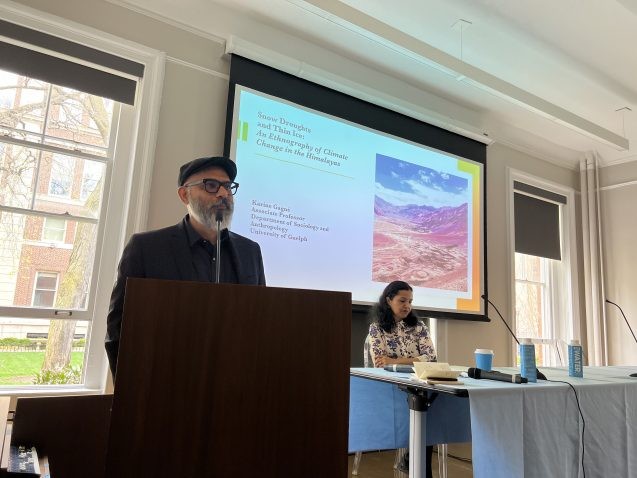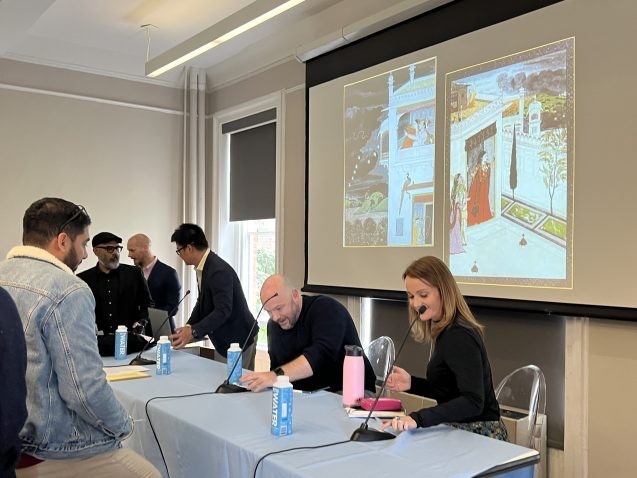First 'Worlds at Waste' Conference Takes an Interdisciplinary Look at Water in South Asia
From glaciers and landslides to displacement and flooding, two Columbia University professors broke down academic silos and reflected on water issues.

On Friday, April 7, Manan Ahmed stepped up to the microphone and addressed a group of researchers and community members seated in the clear plastic chairs of Columbia University’s Buell Hall. An associate professor in Columbia’s Department of History, Ahmed has spent the last four years co-organizing an event designed to bring together an interdisciplinary group of researchers and practitioners from the physical and social sciences. Earlier this month, the first “Worlds at Waste” conference finally launched.
Ahmed is perhaps an unlikely co-leader for a conference on water and climate change. A historian and medievalist researcher by training, he recalled pushback he’d received from colleagues in his efforts to focus on climate issues. In his mind, however, the links between climate and medieval history are clear. In his opening remarks for the conference, Ahmed noted that the medieval writers whose work he studies often imagined that our world would exist 500 years into the future.
“They literally wrote this down, the idea that history isn’t done and generations after me will complete this,” Ahmed said. “I do not have that luxury. I cannot write that 200 years from now — or 300 years from now, or 100 years from now — that someone will complete my work. So this is a thing that matters to me, even if I’m not writing on ‘climate.’”
It was in this spirit that Ahmed and co-organizer Kavita Sivaramakrishnan, associate professor of sociomedical sciences at the Mailman School of Public Health at Columbia, first conceptualized the multi-part conference. While future iterations will tackle air and land, Friday’s event focused specifically on water issues in the Indian subcontinent.
“When we think about water, we are thinking of its presence, we’re thinking of its absence, but we’re also thinking of the ways in which it’s being interpreted, embodied and lived through in all of our societies, from the Himalayas to the seas,” Sivaramakrishnan said in her opening speech, which followed Ahmed’s. “Those who’ve lived in South Asia may live waiting for water all the time. I think that is a stressor as well as a scarcity that’s been at the heart of this conference.”
The conference also drew community members from around New York with personal ties to the Indian subcontinent. Shan Singh, a taxi cab driver whose family migrated from Pakistan, came to the conference prepared to distribute copies of a one-pager he wrote about the impact of partition on India’s environment and psyche. For him, the conference offered an opportunity to talk about the ways partition has affected not just water, but cross-border livelihoods and imaginations.
“Unfortunately, water is a way to connect people — in the way a funeral is sometimes where people connect,” said Shan. “Water has become so scarce that it’s become a problem that is uniting people, when really we should already be united.”
The first part of the conference, entitled “Melt,” focused on glaciers in northern India. In the spirit of the interdisciplinary conference, reflections from anthropologist Karine Gagné on her work in Ladakh in western India paired with reflections from urban designer Andrew Rumbach on landslides and rural urbanization in Darjeeling in eastern India. In their independent presentations, both researchers noted parallel challenges of localizing their work, whether due to sparse meteorological data availability in certain rural mountain areas or the mismatch between formal government classifications of rural districts versus the on-the-ground pace of development.
“One of the things that fascinated me is, we’re coming from two different disciplines and two different sides, but some of the things we’re observing are the same,” Gagné shared in an interview with GlacierHub after her panel. “Research on glaciers is always focusing on these large, charismatic glaciers that are feeding rivers downstream, but locally there’s very little attention. In reality, people are very reliant on these small glaciers,” Gagné said. “It’s the same kind of thing [with Rumbach’s work]. These small cities are not in focus, because people tend to focus on these larger cities. There’s a lot of similarities.”
Rumbach also noted the parallels between their work on glacier-dependent communities. “We’re all studying the same issues, and trying to come up with positive momentum towards people being safer, happier, and less stressed by climates,” he said in an interview with GlacierHub. However, he also stressed that the conference is, in many ways, the first step towards unifying these research threads. “Putting people in the same room is one thing, which is great,” he said. “But also incentivizing them to actually work together in deeper ways, and produce knowledge in interdisciplinary ways? I think that’s something that’s just really, really difficult.”

The day-long Worlds at Waste conference consisted of four panels; the session on glaciers was just the first. The other panels focused on floods, displacement, and seas. In an email to GlacierHub, Manan elaborated on the idea behind this four-part series for the day, noting that, “the idea is not to isolate along space or border or discipline, but to bring together. What happens in glaciers does not stay in the glaciers; it has effects all the way down to the shorelines.” He also wrote that, while the scholarly community works extensively on displacement and flooding, “there is not a very robust understanding of glacier melt and/or engagement with climate scientists working in those remote spaces. Our intention is to make these communities speak and hear each other.”
For Hung Nguyen, that impact was clear. “I don’t usually go to events with social scientists, so this has been very fascinating for me,” he said in an interview with GlacierHub. A natural scientist at Columbia Climate School’s Lamont-Doherty Earth Observatory who uses tree rings to study past climate, Nguyen’s research primarily focuses on southeast Asia. Still, he shared insights on the way tree ring research can inform histories of floods and flood preparedness in the subcontinent.
“It’s really fascinating to hear about displacement in terms of ecology and people at the same time,” he said. “For me, this is a bridge to get to know more about South Asia, so that’s really helpful.”
Adam Sobel, a professor at Columbia’s School of Engineering and Applied Sciences who presented his work on urban floods, reflected on the role that convenings like these play on climate science. “I think what climate science needs is more engagement with the human issues that our science hinges upon,” he said. “So much about climate is inextricable from all these other local, global, geopolitical, economic and cultural issues, because everything exists within a planet that has a climate. It’s easy for our science to get separated from all of that. So, it’s good to have events where we have interdisciplinary conversations. It’s a cliché, but it’s not easy to do it.”
With the “water” portion of the conference now complete, Ahmed and Sivaramakrishnan are looking forward to holding future “Worlds at Waste” conferences that focus on land and air. The organizers plan to hold these subsequent conferences in the next academic year, and hope to facilitate conversations between researchers from different nations and disciplines. From these conversations, new visions may emerge to address the water crisis and climate change for the Indian subcontinent — and for the world.
